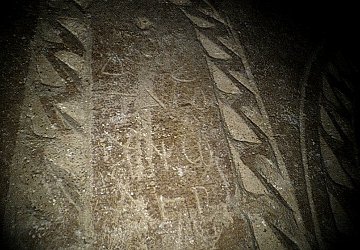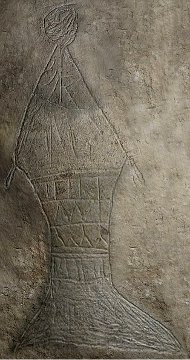Another Tomb of Christ
The team which shot to fame in the 1980s with the claim that they had discovered the tomb of Jesus in Jerusalem has done it again. Once more the television programme makers are claiming to have discovered the tomb of Jesus in the same area of Jerusalem.
The Talpiot tomb was the subject of the first claim on the basis of the ossuaries inside it which bore names that were similar to those of Jesus' family. The tomb is three miles south of the Old City and contained ten ossuaries, six of which bore names scratched into the limestone. The names were Mary, Yose (Joshua? Joseph?), Juda son of Jesus, Matya, Maramene and Jesus son of Joseph. For some reason this tomb came to the attention of James Cameron, a Canadian film maker, who produced a television documentary which claimed the names were those of Jesus' family.
According to the theory worked out by Cameron, journalist Simcha Jacobovici and author Charles Pellegrino, notable for his book "Unearthing Atlantis", Jesus son of Joseph was the Christian Jesus, Mary was His mother, Maramene was Mary Magdalene the wife of Jesus, and Juda was their son. Needless to say, these claims have been dismissed by every competent archaeologist. Amos Kloner, who first investigated the tomb, dismissed the claims saying, "They just want to get money for it. ... The documentary film makers are using it to sell their film."
Andrey Feurverger, a professor of statistics and mathematics at Toronto University, claims to have worked out by statistics that the chances of that particular set of names occuring at random provides solid evidence that the tomb is the tomb of Christ. A close look at his claim reveals so much "hand waving" that really his figures are nothing more than guesswork. For example, he divides his initial figures by four "to account for bias in the historical record"; but why four? Why not five? How exactly do you calculate "bias in the historical record"?
Now Mr Jabovici is attempting to play the same card and earn more money with another film. This time he has been using modern technology to drill holes in the rock around the suburb of Talpiot and insert a camera to investigate anything that looks promising. Beneath the patio of one of the housing complexes in Talpiot he has found another tomb containing ossuaries.
Owing to the sensitivities of Orthodox Jews, who prohibit any interference with Jewish tombs, he has not been able to enter the burial chamber. This means that the photographs he has been able to take are with a remotely operated camera, using lighting sent down the same hole in the rock. The result is that the photographs are not as clear as would be the case if the ossuaries could be properly lit.

| |
| The Greek inscription is claimed to read "O Divine Jehovah raise up raise up". |
One ossuary bears four lines of what appears to be Greek, but the letters are not all that clear. Jacobovicic and his colleague James Tabor claim that it reads "O Divine Jehovah raise up raise up". On the other hand, it could be "Divine Jehovah raises up to the hOly Place" or even "Divine Jehovah raise up from".
Frankly, the proposed translation is nonsense. The term "Jehovah" is a nonsense word created by Christian scholars who mis-read the Hebrew Scriptures. The Jews regarded the four consonants of the name of God, YHWH, as too sacred to pronounce (and in any case had forgotten how they should be pronounced because ancient Hebrew was written without vowels). The Masoretes, who worked between the 7th and 11th centuries AD, devised a system of dots and dashes that could be put above or below the consonants, thus giving a guide to pronunciation without interfering with the sacred lettering.
As a memnonic, the Masoretes inserted the vowels for the word "adonai" around the Tetragramaton YHWH and this reminded cantors and others reading the Hebrew Bible that although the word was YHWH, the reader must say "adonai". Christian scholars, unaware of this convention, read the word as "YaHoWaiH" or Jehovah, something no Jew would ever do and certainly not a first century AD Jew!

| |
| A shape claimed to represent Jonah in the fish - but which is probably an incense burner. |
However, let us suppose that the second line does indeed read "Yaho", which could be the name of God (though frankly the letters look like TALO to me!) and that the rest of the inscription has also been read correctly (though Jacobovici and Tabor admit that the final line is virtually undecipherable in their photographs). How does an invocation urging God to "rise up" or even "raise up" give evidence that this is the tomb of Christ?
A second ossuary has a shape scratched into the lid which Jacobovici and Tabor claim is a fish with a stick man in its mouth, a clear reference - so they say - to the story of Jonah. However the "fish" has a circle of scratches at the pointed end which is a little strange for an inhabitant of the deep. On the other hand, tip the shape on its end and you have a perfectly respectable incense burner with flames or a cloud of incense rising from it. After all, where is the fish's eye?
As for Jonah, it takes a determined imagination to see a "stick man" in the scratched lines at the pointed end of the shape. People see what they want to see and the prospect of making a fortune out of a lacklustre documentary about drilling holes in rocks is a powerful inducement to seeing what isn't there.
The very most that can be said is that this new tomb belonged to someone who believe in the resurrection of the dead - and even that is pushing it a bit. There is no evidence that the person was Christian, for a Christian would expect the dead to be raised by Jesus, not by Jehovah.
In short, given the choice between watching Simcha's latest documentary or an old episode of Tom and Jerry, I would heartily recommend the cat and mouse duo. Both are fictitious, but at least the cartoon is amusing.
© Kendall K. Down 2012





